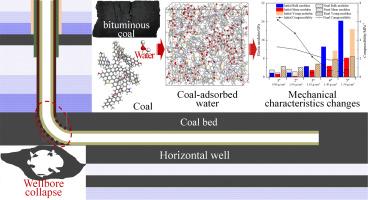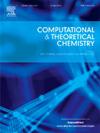Investigation on the micro-mechanism of borehole instability in coalbed methane reservoirs by molecular simulation
IF 3
3区 化学
Q3 CHEMISTRY, PHYSICAL
引用次数: 0
Abstract
To investigate the micro-mechanism of borehole instability in coalbed methane reservoirs, diverse pore-structured reservoir models were constructed based on the structural characterization of demineralized coal. Subsequently, the behavior of coal-adsorbed water, adsorption energy and hydrogen bonding within adsorption system, and the mechanical properties of coal matrix with adsorbed water, were explored utilizing grand canonical ensemble Monte Carlo and molecular dynamics simulation. The findings demonstrate that the saturated adsorption capacity of reservoirs dominated by super-micropores is 2.04–99.5 times higher than that of ultra-micropores due to the fact that the adsorption sites coincide with the pore structure characteristics. And the adsorption potential energy distribution similar to the pore size distribution of coal matrix, highlighting the influence of pore structure on the interaction between water and coal. Furthermore, the average length of hydrogen bonds within reservoirs dominated by super-micropores is relatively short, indicating stronger intermolecular interactions within the adsorption system than that of ultra-micropores. Additionally, the coal-adsorbed water plays a pivotal role in borehole instability. For normal reservoirs, adsorbed water results in a decrease of 9.08–34.06 % in elastic modulus (E), weakening the mechanical properties of reservoir stratum during the drilling process. However, different internal stress status within coal seam led to distinct mechanisms of borehole instability, internal stress release within abnormal high-pressure reservoirs leads to coal matrix expansion, and changes in the pore structure cause a decrease of 31.24–75.97 % in E, substantial water filled in the loose pore structure of abnormal low-pressure reservoirs resists elastic deformation induced by external forces.

煤层气储层井眼失稳微观机理的分子模拟研究
为探讨煤层气储层井眼失稳的微观机理,基于脱矿煤的结构表征,构建了多种孔隙结构储层模型。随后,利用大正则系综蒙特卡罗和分子动力学模拟,探讨了煤吸附水的行为、吸附能和吸附体系内的氢键,以及煤基体吸附水的力学性能。结果表明,超微孔为主的储层饱和吸附量是超微孔的2.04 ~ 99.5倍,这主要是由于其吸附部位与孔隙结构特征相吻合。吸附势能分布与煤基质孔径分布相似,突出了孔隙结构对水煤相互作用的影响。此外,在以超微孔为主的储层中,氢键的平均长度相对较短,表明吸附体系内的分子间相互作用强于超微孔。此外,煤吸附水在井眼失稳中起着关键作用。对于正常储层,吸附水使其弹性模量(E)降低9.08 ~ 34.06%,削弱了钻井过程中储层的力学性质。然而,煤层内部不同的内应力状态导致钻孔失稳机制不同,异常高压储层内部应力释放导致煤基质膨胀,孔隙结构变化导致E减小31.24 ~ 75.97%,异常低压储层疏松孔隙结构中大量充水抵抗外力引起的弹性变形。
本文章由计算机程序翻译,如有差异,请以英文原文为准。
求助全文
约1分钟内获得全文
求助全文
来源期刊

Computational and Theoretical Chemistry
CHEMISTRY, PHYSICAL-
CiteScore
4.20
自引率
10.70%
发文量
331
审稿时长
31 days
期刊介绍:
Computational and Theoretical Chemistry publishes high quality, original reports of significance in computational and theoretical chemistry including those that deal with problems of structure, properties, energetics, weak interactions, reaction mechanisms, catalysis, and reaction rates involving atoms, molecules, clusters, surfaces, and bulk matter.
 求助内容:
求助内容: 应助结果提醒方式:
应助结果提醒方式:


